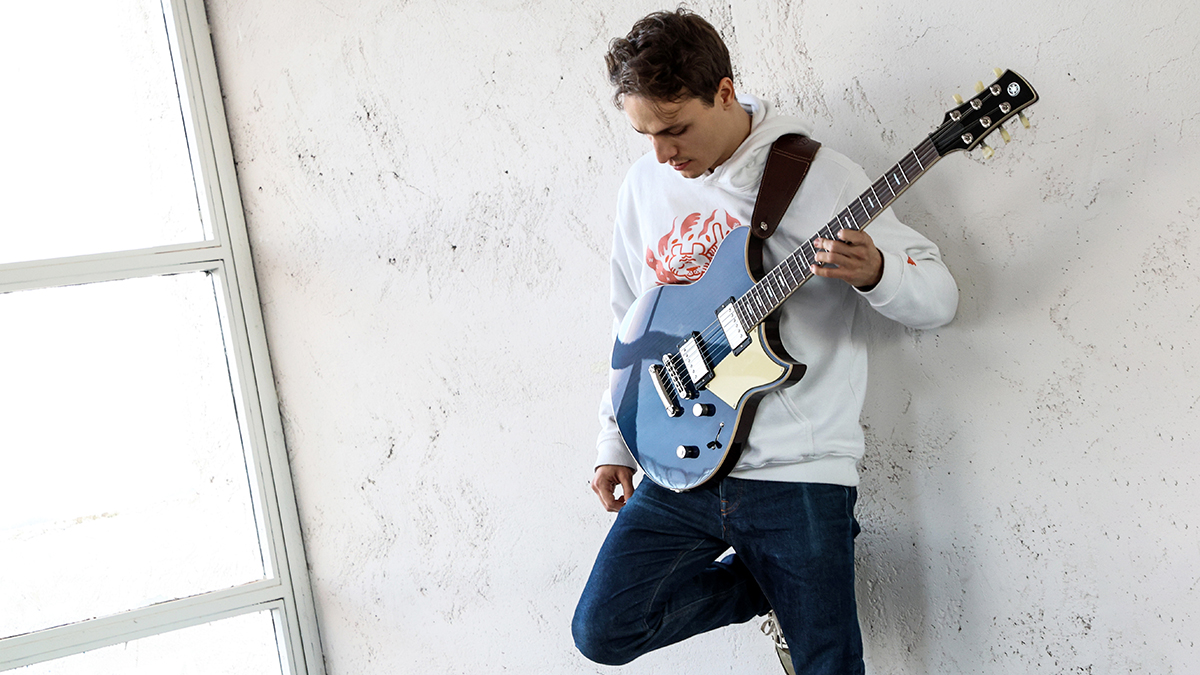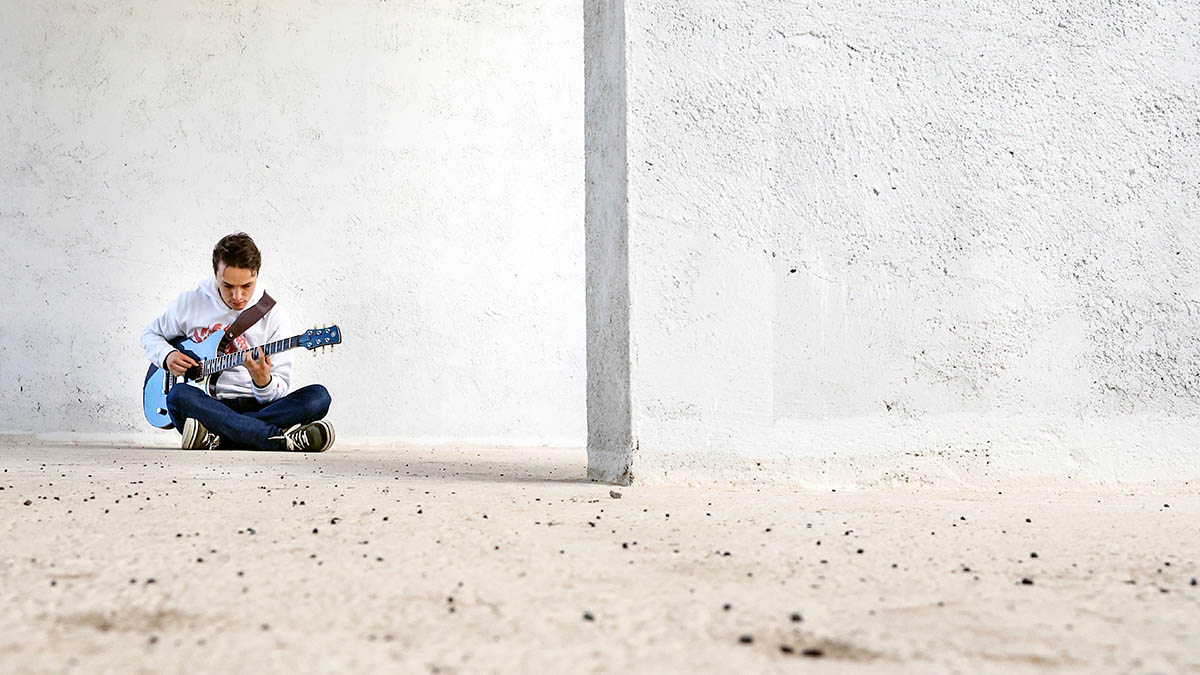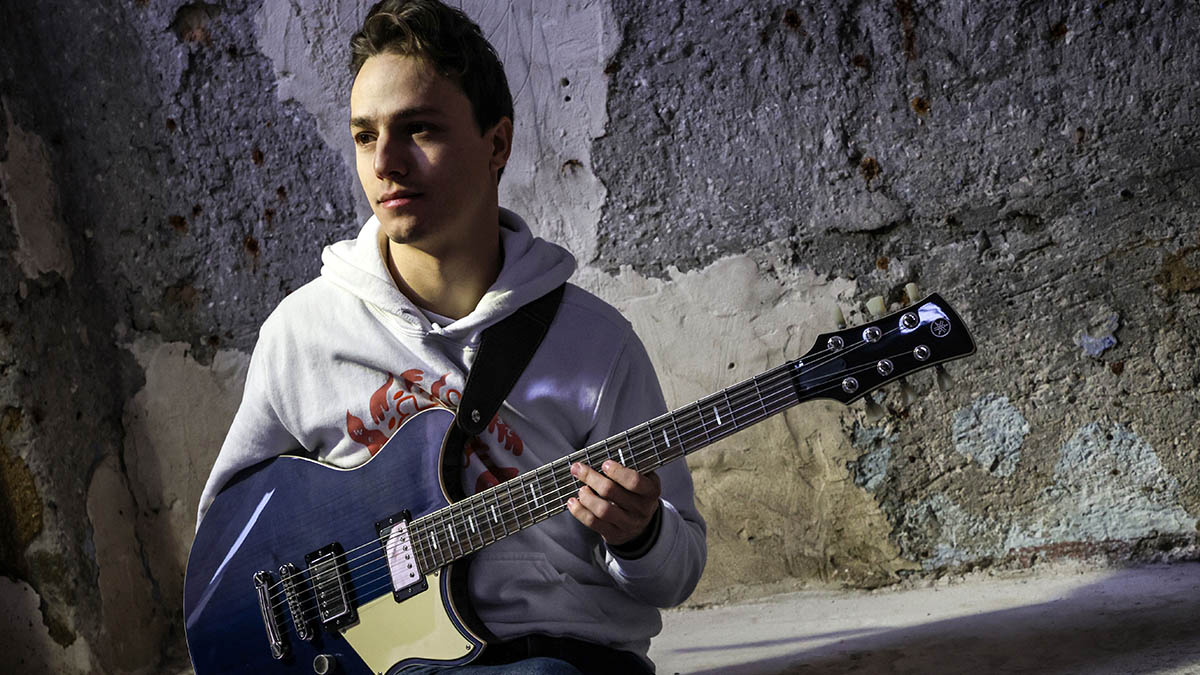Steve Vai called him “the evolution of the guitar” while Al Di Meola said his playing was “light years ahead”. We meet Matteo Mancuso, the young guitarist redefining virtuosity
The Sicilian virtuoso is at the forefront of technical guitar playing, but as he explains, “I’m not a shredder and I’m not a jazz player – I listen to a lot of different stuff and I wanted it all in my music… You need to be open-minded”

He starts with a disclaimer (“I apologise in advance for my English…”). But Matteo Mancuso needn’t worry. The 26-year-old Sicilian is sharp, witty and rarely lost in translation – we can only imagine how much fun he’d be if you could loosen his mother tongue over a few drinks.
And besides, who needs words when you have Mancuso’s lyrical touch on guitar? Debuting with a Hendrix cover at a local festival aged 12, fusing boundless influences into his peerless/pickless jazz-shred style, notching up 158k followers on YouTube and feted by the instrumental super-league, his debut album, The Journey, feels like the dawning of a new world order.
Are you pleased with how The Journey turned out?
“I took four years to record this album, so some of the songs sound old to me, but I’m really happy with the result. Am I a better player now than when I started? Maybe, yeah. I’ve learnt different ways to compose.
“When I was younger, I’d tend to write riff-based songs. For example, Drop D is one of the first compositions I wrote for the album, and it sounds like a teenage song to me. But that’s why I like the album. All the songs are very different.”
What inspired you to give Drop D that title?
“Actually, it’s not really a title, it’s more of a reminder. I’d always play that song live, and I often forgot to tune my guitar in drop D, so I called it that so I’d remember. But also, I love rock as much as jazz. My first influences were Deep Purple, Led Zeppelin, Jimi Hendrix – he was the first to make me pick up a guitar.
Get The Pick Newsletter
All the latest guitar news, interviews, lessons, reviews, deals and more, direct to your inbox!
“Drop D feels like a tribute to all those groups combined, from the rock era to prog-rock like Emerson, Lake & Palmer, Yes and Dream Theater. I almost called it Stormchaser because I’m a big fan of disaster movies. When the Earth is in danger, like a big asteroid or hurricane, I’m happy. When I wrote that song, I imagined a giant tornado following an old truck!”
My first influences were Deep Purple, Led Zeppelin, Jimi Hendrix – he was the first to make me pick up a guitar
What’s your own favourite guitar moment on The Journey?
“The solo on Blues For John I think is good because it’s a mix of Eric Johnson with a Bonamassa kind of blues feel. At the same time, there’s a lot of jazz elements. ‘John’ is John McLaughlin – it’s dedicated to him.”
Can you tell us about your setup for the album?
“For most of the songs, I used my custom Yamaha Revstar and I played a Yamaha Pacifica on Silkroad. But then I borrowed a few guitars from my dad [Vincenzo Mancuso] for some of the rhythm parts – he hoards guitars at home so I could choose whatever I want. His best guitar is probably this really beautiful Heavy Relic Sunburst Strat. He’s got one or two stories for every guitar.”

Your father, Vincenzo Mancuso, is a former session ace. He must have made a very big impression on you?
“Yeah, he was an inspiration from the start. I consider him one of the best players in the world, not because he’s my father but because he’s capable of doing the right thing, at the right time, on every song. He’s a producer as well as a player: he worked with many Italian singers from the ’90s. He was more of a listening guide than just a teacher.
“I started listening to traditional jazz stuff thanks to him, got to know Wes Montgomery, Barney Kessel, Django Reinhardt, a lot of these jazz cats. I have to thank my father because I never thought there was so much music in the world. When I was 12, I played live for the first time with my father. We did two Hendrix songs – Little Wing and Voodoo Child – at one of the biggest festivals in Sicily.”
Allan Holdsworth is one of my biggest heroes. Guthrie Govan is the epitome of the modern player
Who were the other players that put you on this path?
“The first inspirations were Ritchie Blackmore and Jimmy Page. One of the first solos I learned was Heartbreaker. Later on, I discovered Eddie Van Halen and that was a game-changer – I started to dig into the tapping technique. Eric Johnson is a really big influence, and when I was around 16 I was listening to Frank Gambale and Robben Ford. Allan Holdsworth is one of my biggest heroes.
“I think Guthrie Govan is the epitome of the modern player, y’know? Steve Vai, of course. Yngwie Malmsteen. Joe Satriani. John Petrucci. All these guys are heroes for me. I’d love to play in a G3 someday. There are also a lot of sax and piano players I listened to, especially when I was studying at the conservatory in Palermo. One of my favourites was Michael Brecker. Piano players like Oscar Peterson. Jazz guitarists like Joe Pass.”

Why do you think there are so many great players of Italian descent – Vai, Satriani, Petrucci and so on?
“I don’t know – maybe it’s the food! As a young player in Sicily, I already knew there wasn’t much instrumental music, so to go out and play, you really have to learn a lot of styles. If you know blues, jazz, rock, pop – you get more gigs.
“Can I hear my roots in my playing? I think the Sicilian influence is more on my lifestyle than my music. Sicilian people, we always try to take it easy, take our time… that’s why it took me four years to make an album!
“We are a really lazy people in general, especially people from Palermo, and I think the quality of life is better if you take it slowly. I always try to take it easy, be late, eat a lot – that’s the Sicilian in me. Also, of course, the music – we don’t take it too seriously. I don’t consider myself forced to do this. It’s what I love and when you love your job, you don’t work a day in your life.”

To return to your gear – do you modify those Yamahas?
“The Pacifica is always stock. My custom Revstar is really similar to the Revstar Professional, but it has some modifications. For example, the fretboard wood is called pau ferro. It’s a substitute for rosewood, very similar in sound but more resistant to temperature changes. My Revstar also has Lollar Imperial humbuckers and a five-way switch so I can split them.”
The Pacifica is known as the king of budget guitars. Can a cheap model still cut it at the professional level?
“Yes, especially Yamaha ones. That’s their strong point: they can really make cheap guitars sound professional. Of course, there are better Strat [-style instruments] out there. I’m not saying the Pacifica is the GOAT of Strat [styles]. What Yamaha can do well is make a low-priced guitar sound great.
“But I think they still have to build a really good Strat [style]. Because the Pacifica, it’s good for the price, but it’s not good if you compare it to a Custom Shop Strat or something. Not because Yamaha can’t do it, but they don’t have [anything in that price range] yet.”
We don’t see many physical guitar amps in your backline?
“No, with amps, I only use digital simulations. First of all, because I’m a lazy guy, I don’t like to mic amps and do all the analogue work. So my first choice was digital because I think it’s more reliable in a recording setting: you always have the same sound every day.
“With an analogue amp, you have mic’ing, you have the tubes, you have the distance from the mic to the cab – there are a lot of aspects you can’t really control. 90 per cent of the sounds you hear on this record are from the Line 6 Helix. I used various amp models but mostly ‘Matchstick Ch2’ [Matchless] for my lead sounds and ‘US Deluxe Nrm’ [Fender Twin] for clean.
“Live, my pedalboard goes straight to the PA. I get everything from the Helix – digital delay, reverb, chorus. It’s amazing.”
Where do you stand on the whole digital debate?
“People tend to think digital sounds worse than analogue. But that’s only because you have to work on it. The analogue starting point is better, but the moment when you realise how the pedalboard works and how you achieve a particular sound, you can achieve basically anything you ever wanted. Digital pedalboards are limitless.”
On an instrumental song, you can think about love, happiness, sadness. There’s no language barrier. Instrumental music, it’s universal
Are you playing a sitar on Falcon Flight?
“Actually, it’s my father’s old Roland VG-88 pedal. I mounted a piezo pickup on my Revstar to get that sound. It’s a strange sound, but it was worth it.”
What’s the secret to creating mood or telling a story without using words?
“I always composed without lyrics, so it was second nature to me. I think instrumental music is more personal. If you listen to a vocal song, you’re influenced by the words. If it talks about love, you immediately think about love.
“On an instrumental song, you can think about love, happiness, sadness. There’s no language barrier. Instrumental music, it’s universal. You can listen to Europa by Santana and you don’t have to be Spanish to understand it.”

Some people say you’re a shredder, others that you’re a jazz player – what do you think you are?
“I’m not a shredder and I’m not a jazz player [laughs]. As much as I love shredding, I don’t want that to be the focus point. At the same time, I don’t consider myself a pure jazz player. I’ve played a lot of jazz standards in my life, especially at high school and the conservatory.
“But I listen to a lot of different stuff and I wanted it all in my music. To play this kind of music, you need to be very open-minded. I consider myself mainly a rock player with some jazz influence. My inspirations are people like Frank Gambale, Allan Holdsworth – all players that listened to a lot of jazz, but there’s a rock or rock-blues element to their playing. So that’s how I picture myself.”
Playing with fingers, you basically have four different picks, so it’s better for string-skipping and you can choose the combination of the arpeggio better than if you had a pick
Everyone says your technique is unique – what are you doing differently, do you think?
“I think the unusual thing for other players is that I play electric guitar with fingers, but I don’t think what I’m doing is unique. Basically, I mainly use two positions for my right hand: one is a bass-like technique and the other one is more like classical technique. There are advantages and disadvantages.
“For example, playing on the same string is way easier with a pick because it’s a simpler movement. But playing with fingers, you basically have four different picks, so it’s better for string-skipping and you can choose the combination of the arpeggio better than if you had a pick.”
Did you try a guitar pick and not like it?
“I went straight to fingers, but that was really because I saw my father playing classical guitar at home. He was always playing with fingers, so I thought every guitar was meant to be played like that. Later on, I discovered the pick, of course, but I was already used to playing with fingers. I did play with a pick sometimes, but it felt unnatural, I don’t know why. It didn’t feel right.”
What’s the secret to standing out as a guitarist on YouTube?
“I think you have to be original with your material. You can’t just do popular covers. Back in the day, I did a cover of Eric Johnson’s Cliffs Of Dover, but then I switched to improvising over backing tracks or doing covers that are really personal, like my own arrangement of Larry Carlton’s Room 335. And actually, the pandemic helped me do more videos because I was always at home.
“That’s when people like Steve Vai and Al Di Meola talked about me because I was uploading a lot of videos and finally getting a bit of attention. I don’t consider myself a very good content creator. As I say, I can be a lazy guy, so I’d do one video per month and, of course, for today’s standards, that’s not enough. I want to play live as my first activity – and making videos as the second or third activity.”
A post shared by Matteo Mancuso (@matteomancuso.guitar)
A photo posted by on
Do you find that people still call you a guitar prodigy?
“I’m too old for that now – I’m 26! I don’t consider myself as talented as people think. And that’s because I know my musical skills are not really from talent, they’re from hard work. People sometimes overestimate talent…”
- The Journey is out now via Mascot Label Group/The Players Club.
Henry Yates is a freelance journalist who has written about music for titles including The Guardian, Telegraph, NME, Classic Rock, Guitarist, Total Guitar and Metal Hammer. He is the author of Walter Trout's official biography, Rescued From Reality, a talking head on Times Radio and an interviewer who has spoken to Brian May, Jimmy Page, Ozzy Osbourne, Ronnie Wood, Dave Grohl and many more. As a guitarist with three decades' experience, he mostly plays a Fender Telecaster and Gibson Les Paul.
“I was writing songs from eight years old, but once I got a guitar I began to deeply identify with music… building an arsenal of influences”: How Lea Thomas uses guitars her dad built to conjure a magic synthesis of folk, pop and the ethereal
“I liked that they were the underdogs. It was not the mainstream guitar. It was something that was hard to find”: Vox guitars deserve a second look – just ask L.A. Witch’s Sade Sanchez, who’s teaming hers with ugly pedals for nouveau garage rock thrills











